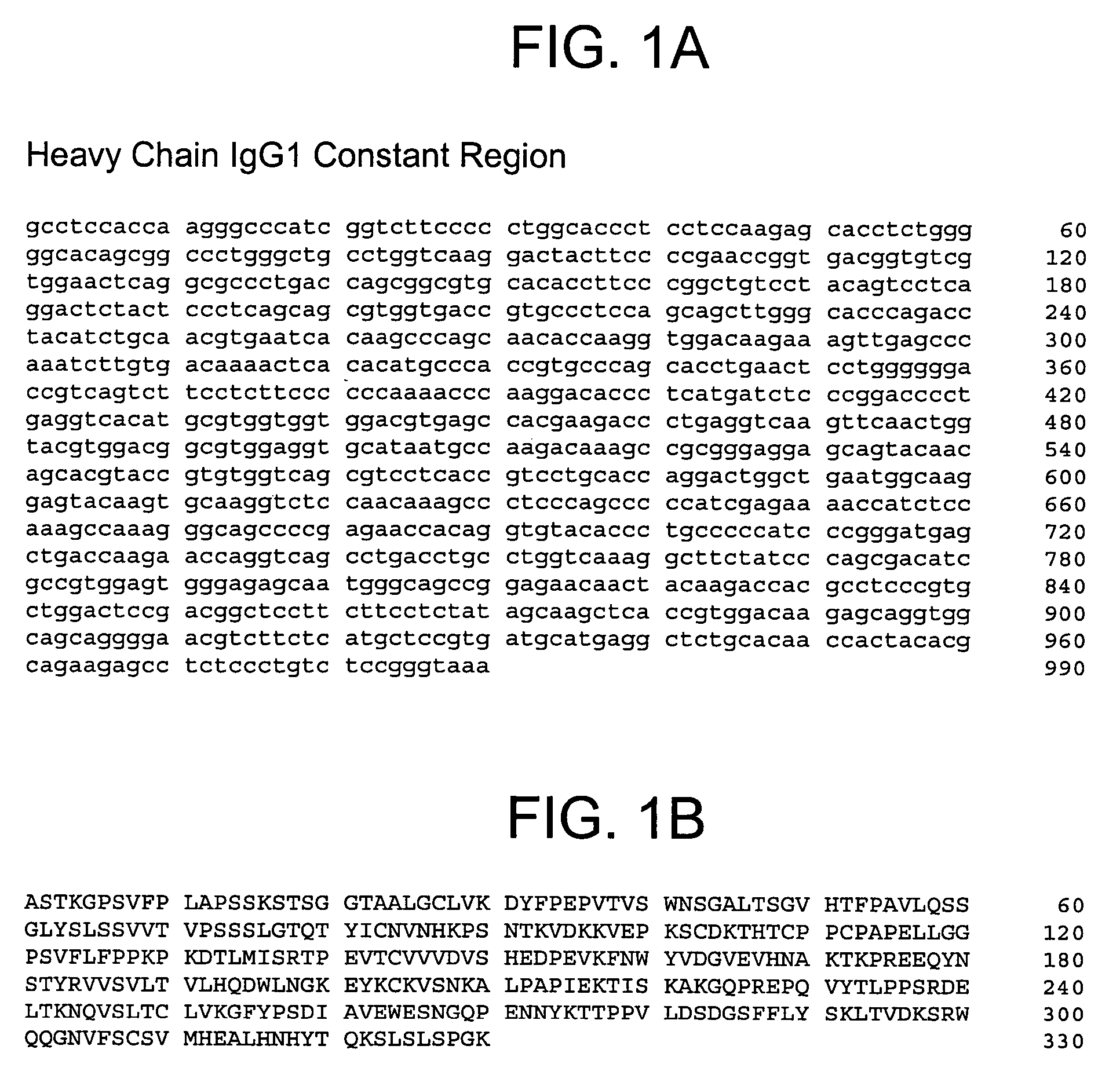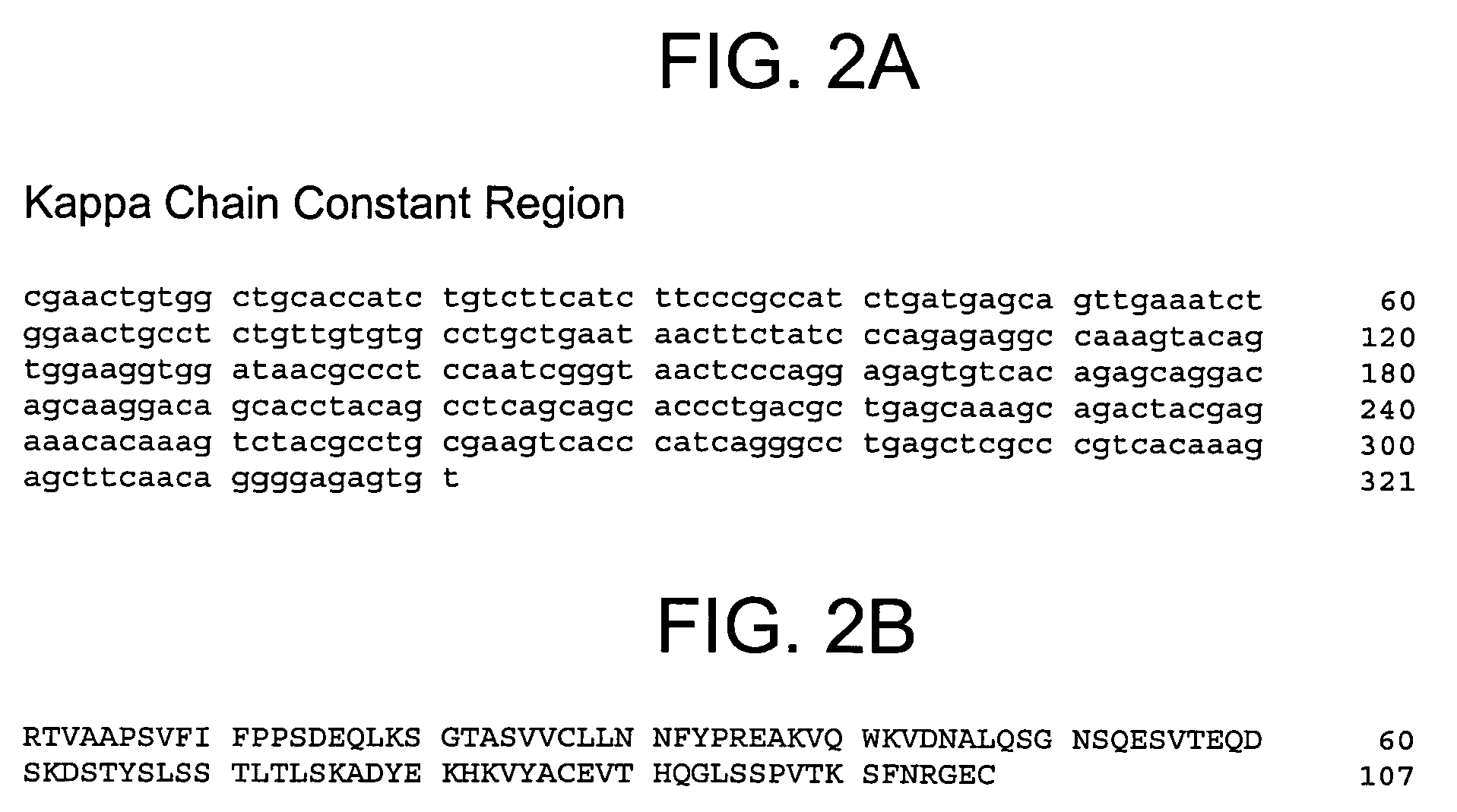Human anti-IFN-γ neutralizing antibodies as selective IFN-γ pathway inhibitors
a technology of neutralizing antibodies and ifngamma, which is applied in the field of human monoclonal antibodies, can solve the problems of inadvisable chronic use of such antibodies in humans, and is not possible, and achieves the effects of not inhibiting or modulating biological activity, and preventing or antagonizing the inhibition of biological activity
- Summary
- Abstract
- Description
- Claims
- Application Information
AI Technical Summary
Benefits of technology
Problems solved by technology
Method used
Image
Examples
example 1
Generation of Human IFNγ Protein from CHO Cells
[0219]The full-length human IFN-γ cDNA was amplified by PCR (under standard conditions) using human spleen Marathon-Ready cDNA (Clontech) as a template. The sequence was subcloned into the pDSRα2 plasmid. DH10B (Escherichia coli) cells were transformed with the pDSRα2 plasmid. DNA was prepared using standard techniques, and CHO cells were transfected by the calcium phosphate method (Speciality Media, Inc.). A high-expressing cell line clone was used to generate serum-free conditioned media.
[0220]CHO cell conditioned media containing human IFN-γ (hu-IFN-γ was concentrated, dialyzed, and purified through several chromatography steps. The first step was Q-HP (Pharmacia) chromatography using a standard NaCl gradient to separate highly glycosylated from unglycosylated hu-IFN-γ forms. The Q-HP pool was further purified through wheat germ agglutinin chromatography (EY Laboratories). The purified material was separated by SDS-polyacrylamide gel...
example 2
Production of Human Monoclonal Antibodies Against IFN-γ
Transgenic HuMab Mice
[0221]Fully human monoclonal antibodies to IFN-γ were prepared using HCo7, HCo12, and HCo7+HCo12 strains of transgenic mice, each of which expressed human antibody genes. In each of these strains, the endogenous mouse kappa light chain gene had been homozygously disrupted as described in Chen et al. (1993, EMBO J. 12:811-820), and the endogenous mouse heavy chain gene had been homozygously disrupted as described in Example 1 of International Patent Application Publication No. WO 01 / 09187 (incorporated by reference). Each strain carried a human kappa light chain transgene, KCo5, as described in Fishwild et al. (1996, Nature Biotechnology 14:845-851). The HCo7 strain carries the HCo7 human heavy chain transgene as described in U.S. Pat. Nos. 5,545,806, 5,625,825, and 5,545,807 (incorporated by reference). The HCo12 strain carried the HCo12 human heavy chain transgene as described in Example 2 of International ...
example 3
Cloning the Anti-IFN-γ Antibody Heavy and Light Chains
[0231]The hybridomas expressing IFN-γ binding monoclonal antibodies 1119, 1121, 1118*, 1121*, and 1118 identified in Example 2 above were used as sources to isolate total RNA using TRIzol® reagent (Invitrogen), a monophasic solution of phenol and guanidine isothiocyanate suitable for isolating total RNA, DNA, and protein. First strand cDNA was synthesized using a random primer with an extension adapter (5′-GGC CGG ATA GGC CTC CAN NNN NNT-3′) (SEQ ID NO:23) and a 5′ RACE (rapid amplification of cDNA ends) preparative assay was performed using the GENERACER™ Kit (Invitrogen), a kit for rapid amplification of cDNA ends (RACE) with improved efficiency, according to instructions from the manufacturer. For preparing complete light chain-encoding cDNA, the forward primer was the GENERACER™ nested primer, and the reverse primer was 5′-GGG GTC AGG CTG GAA CTG AGG-3′ (SEQ ID NO:24). The reverse primer was designed to recognize a conserved ...
PUM
| Property | Measurement | Unit |
|---|---|---|
| equilibrium dissociation constant | aaaaa | aaaaa |
| equilibrium dissociation constant | aaaaa | aaaaa |
| equilibrium dissociation constant | aaaaa | aaaaa |
Abstract
Description
Claims
Application Information
 Login to View More
Login to View More - R&D
- Intellectual Property
- Life Sciences
- Materials
- Tech Scout
- Unparalleled Data Quality
- Higher Quality Content
- 60% Fewer Hallucinations
Browse by: Latest US Patents, China's latest patents, Technical Efficacy Thesaurus, Application Domain, Technology Topic, Popular Technical Reports.
© 2025 PatSnap. All rights reserved.Legal|Privacy policy|Modern Slavery Act Transparency Statement|Sitemap|About US| Contact US: help@patsnap.com



